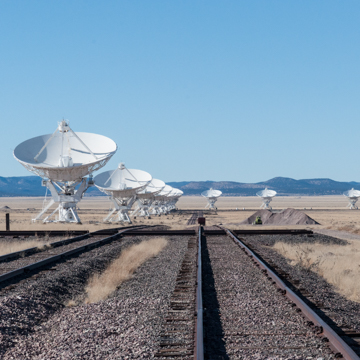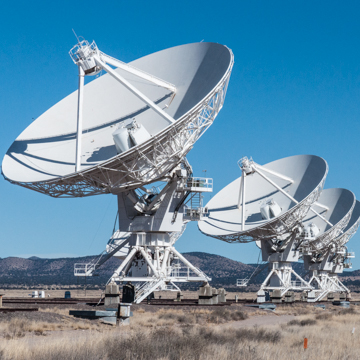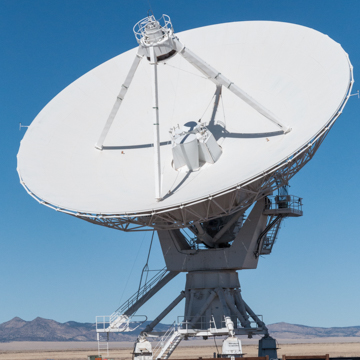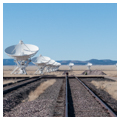You are here
Karl G. Jansky Very Large Array
The Very Large Array (VLA) is a monumental work of science and engineering. Its scale, parts, and functioning make it an important built work in its own right, as well as a demonstration of theoretical possibilities that have been explored yet never fully realized in architecture.
Authorized by Congress in 1972 as one in a series of National Radio Astronomy Observatories, the VLA was built between 1974 and 1980 in the Plains of San Agustin some 50 miles west of Socorro. What is technically a large-scale interferometer array collects cosmic radio waves to order to look at the universe. Its location, in an ancient dry lakebed ringed by mountains at 7,000 feet, was chosen because the site is flat and free from the interference of both distorting water molecules in the air and human radio signals.
Twenty-seven dish antennae, and one spare, are stationed along a “wye,” a Y-shaped configuration of three arms separated by 120 degrees and extending 13 miles. The nine antennae on each arm are moved at four-month intervals between 24 pads (72 total) along double railroad tracks into four configurations, called A, B, C, and D. In these four configurations, the 27 antennae function as a single telescope; A, the largest at 22.62 miles across, provides the highest resolution, which grows progressively more diffuse down to the smallest D configuration at 0.64 miles.
Every antenna weighs 230 tons, is supported on a steel armature, and has a dish 82 feet in diameter. The dishes rest on an altitude-azimuth mount that, like the mount on a camera tripod, allows them to pivot vertically and horizontally. Also like a camera tripod, each antenna stands on three braced legs that fit foundation piers at each station pad. Two locomotive transporters, with twelve pairs of wheels that run on the double railroad tracks, move the antennae from pad to pad.
Once in place, the 27 individual antennae are rotated in synchrony to focus on the same distant part of space. The paraboloid dishes, surfaced with aluminum panels, collect and direct radio waves back up to a sub-reflector, which in turn directs the waves back down to one of six to eight “feed horns” grouped below, each tuned to a different frequency (wavelength) of interstellar radiation. Converted from analog to digital signals, the separate feeds from the 27 antennae are sent to the Control Building, where their data is “correlated” into a single image.
This scientific complex is also a site of political and architectural significance. Politically, the authorization of the VLA in 1972 coincided with the end of NASA’s Apollo missions to the Moon while also continuing the American quest to explore outer space.
Architecturally, these mobile structures are the size of multistory buildings that, when mobilized, move across an area equivalent to a small city with integrated power, transportation and information systems. Though built for specific scientific purposes, the VLA has parallels to such utopian schems as Buckminster Fuller’s prescriptions for “spaceship earth,” which sought to close the gap between architecture and modern technology through an integrated systems approach to multiple social problems. Fuller’s ideas, in turn, inspired the visionary polemics of the British group Archigram, including Ron Herron’s “Walking City,” a series of gigantic, mobile, robotic structures that functioned as mobile living pods. While nothing practical came of this, the architecture of the VLA—like the architecture of NASA’s Apollo program—shows how their ideas might have worked.
Besides the antennae, tracks, transporters, and control building, the complex includes the assembly building, where the antennae were originally assembled and are now maintained. In 2001–2010, the facility was completely updated as the Expanded VLA, with new electronics and a state-of-the-art digital “correlator” called WIDAR (Wideband Digital Interferometric Architecture). In 2012, it was rededicated as the Karl G. Jansky Very Large Array, after the scientist who discovered cosmic radio waves in 1932.
The Visitor Center is open to the public during regularly scheduled hours, when self-guided tours are also available.
References
Fuller, R. Buckminster. Operating Manual for Spaceship Earth. New York: Pocket Books, 1970.
Healy, Kevin. “A Window on the Plasma Universe: The Very Large Array.” Astrophysics and Space Science, CCXXVII, no. 1-2 (May 1995): 83-91.
Sadler, Simon. Archigram: Architecture without Architecture. Cambridge: MIT Press, 2005.
"Telescopes." National Radio Astronomy Observatory. http://public.nrao.edu/telescopes/vla.
Writing Credits
If SAH Archipedia has been useful to you, please consider supporting it.
SAH Archipedia tells the story of the United States through its buildings, landscapes, and cities. This freely available resource empowers the public with authoritative knowledge that deepens their understanding and appreciation of the built environment. But the Society of Architectural Historians, which created SAH Archipedia with University of Virginia Press, needs your support to maintain the high-caliber research, writing, photography, cartography, editing, design, and programming that make SAH Archipedia a trusted online resource available to all who value the history of place, heritage tourism, and learning.












